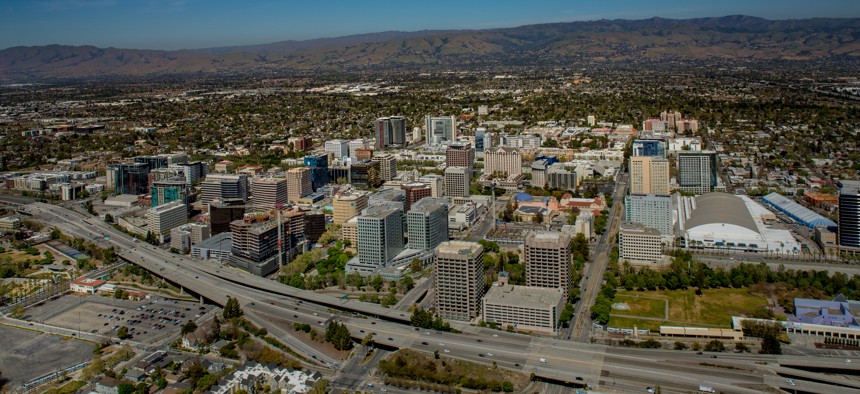Capturing AI’s potential needs a ‘two-way street’ between the feds and states, cities

Aerial view on San Jose, California. Steve Proehl/Getty Images
A senior White House official said all levels of government need to work together on artificial intelligence to “move faster” to tackle big problems.
Figuring out how to regulate and best use AI will be a “two-way street,” a senior White House official said this week. The federal government can learn from states and localities—and vice versa—on deploying the new technology responsibly and equitably.
The comments were made by Deirdre Mulligan, principal deputy U.S. chief technology officer in the White House’s Office of Science and Technology Policy.
“We are all in this together,” she said at the U.S. Conference of Mayors’ winter meeting in Washington, D.C., adding that what is required is “coordination across all levels of government.”
Mulligan said that might mean states and localities leaning on the federal Office of Management and Budget’s guidance last year on employee use of AI. But it also might mean that federal agencies borrow from Boston, San Jose, California, and others that have introduced their own policies on employee use of generative AI.
Mulligan’s statement came as a relief to many on the stage and in the audience. Following President Joe Biden’s executive order on artificial intelligence last year, state and local governments raced to try to work out what its implications were for them, as many are already steaming ahead in experimenting with AI.
2023 was a big year for AI in cities and states, as policymakers drafted policies and governors issued executive orders mandating the technology’s responsible use. That trend is continuing in the new year, especially as governments work out effective use cases and actually apply AI.
San Jose Mayor Matt Mahan said during the committee meeting that his city has already utilized AI in several ways. The city has outfitted municipal vehicles with cameras to help automatically detect potholes or obstacles in the road, which Mahan said helps “get ahead” of 311 calls for service. San Jose is also using AI to provide real-time translation of city communications, and is exploring it for uses in traffic flow management and gunshot detection.
San Jose has created a small AI unit within its IT department that any agency can go to with a proposed use case for the technology, Mahan said. That unit then provides the agency with a risk assessment and recommendations on how to proceed.
It will be a “long game that’s going to be heavy on experimentation,” he said, adding that his vision is for a “civic sandbox” that allows for pilot projects and collaboration with third-party vendors who can help use AI to solve some of the city’s biggest challenges.
But not every city is nestled in the heart of Silicon Valley like San Jose. For cities not as far along with AI, Amy Holmes, executive director of the Center for Government Excellence at Johns Hopkins University, suggests starting small. Cities could identify one or two issues that would benefit from AI, she said, and notch a “quick win” before tackling bigger tasks.
Other speakers at the meeting also emphasized the need for cities to collaborate in sharing best practices on AI, especially use cases that work well in government. “There are no borders or boundaries at this current moment,” said Seattle Mayor Bruce Harrell.
San Jose is at the vanguard of that collaboration. Mahan called on those present to join the city-led Government AI Coalition, which has already brought together more than 100 government agencies nationwide to create standards for AI procurement and governance. He said AI is “really coming into its own” and groups like these are needed to harness its full potential.
Part of the challenge for the government in 2024 will be walking a fine line between regulation and innovation.
“The state we’re at today [with AI] has not been driven by the federal government,” Beverly Hills, California, Mayor Julian Gold said. “As a point of fact, the state we're at today has been driven largely by private enterprises, which will likely continue to do that at a pace that far exceeds what the federal government can do.”
That’s where intergovernmental collaboration is key. Mulligan said the Biden administration does not want business or governments to "run fast and break things," but rather it wants to see everyone "move faster on both sides" to tackle big problems together.
Mahan called for “restrained” regulation. Overly strong rules could “crowd out innovation and push it to other countries,” he warned.
NEXT STORY: States vie for leadership role on AI






